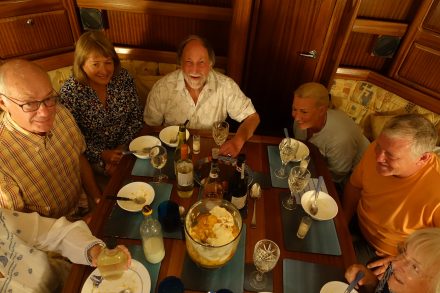- This topic is empty.
-
AuthorPosts
-
June 8, 2017 at 12:30 pm #7017
Anonymous
Genoa cars.
My Bavaria Crusier 37 came with adjustable jib cars. To adjust them you have to leave the cockpit de-power the jib and pull up a pin to move them. To have new line controlled cars fitted, without the lines and clutches I was quoted over £650.00 !!!!!!
Here is what I did. I hope it’s of use to someone.
I ordered two Selden track end stops with double sheaves from Martin Leaning masts and rigging at Port Solent. I believe they were about £60 each? I cannot remember the track size. I would need to dig out the invoice. I then found two Selden double blocks, I believe they were the 30mm size with ball bearings. They were about £35 each.
I removed the end stops from the existing track at the back or rear of the track as there was not enough clearance at the front end to fully remove the cars which clashed with the Jack stay fittings.
I then removed the forward stops at the front end and fitted the new track end stops with the double sheaves. The hole centres were the same so they fitted ok. I used copious amounts of Sika in the holes, around the machine screws and under the end stop. I wiped away any excess while the sealant was still wet. I then covered the holes at the rear end with tape to temporarily keep any moisture out while I worked on the cars.
In my workshop I held the cars in a vice, first wrapping the car in rag to protect it from damage. I removed the stainless steel split pin which holds the plunger top on using a fine pin punch and small hammer. The plunge pin is sprung loaded so that it can locate on the track in a set position. The plunge pin and its spring will simply fall out once the top is removed.
I then cut away the eye on the double blocks and dressed the top on a belt sander (being careful not to heat the stainless and melt the block). I hand finished the block with emery cloth in higher and higher grades. Eventually polishing them with some very fine cloth.
One side of the blocks was sanded to flatten them off as they had a slight curve.
I then put the cars on the milling machine and flattened off the front of the casting back to the end of the plunge pin hole. I took off .10mm more than the top surface of the rim of the hole so that the block seated well on the casting. You could do this with a file or a tool like a Dremmel. But the milling machine makes the job easy and very accurate.
I then placed the double block on the car casting and held it in place with a couple of engineer’s vices. Using a transfer punch (a punch that allows you to make a centre punch mark through a hole) I marked the centre of the hole in the double block on to the car casting, on the centre line.
This punch mark gave me the exact point to drill a 6mm hole in the casting. Turning the casting over I countersunk the underside to take the head of a 6mm stainless steel machine screw. Again you could do this with a hand drill or pillar drill, but the milling machine makes it very easy to maintain accuracy of the hole, not only in location but perpendicular to the car casting.
Using a small brush I painted the aluminium surface that had been milled with a self-etch primer and then a coat of black paint to protect it from the salt water/atmosphere.
I then pushed the 6mm stainless steel machine screw up through the hole making sure that the head was flush with the underside of the casting. I located the block with the flat side down and placed a large stainless steel penny washer on the outside and secured it with a nylock nut of the same grade. (316 stainless). The block was gently, but firmly locked down to the Jib car casting.
The cars were then relocated on the tracks from the rear and the rear end stops replaced. Again with Sikaflex around the bolts and under the fitting.
I rigged lines port and starboard through the cars and the track end stops with double sheaves. Through 4 selden bullseyes (About £20 worth), back to the cockpit. In the cockpit I fitted two Spinlock PRX race cleats with swivels. These are a good way of jamming the lines and can be used from any position in the cockpit they are easy to release or set. They are a good clutch and very easy to fit.
The lines were something like £1.50 a metre. I bought ten metres with a green trace and ten with a red trace but did not use it all. It took an hour or so to do the work on the tracks, fit the four bullseyes and the jammer/clutches.
The stainless steel machine screws, washers, nuts and Sikaflex I had in stock but I guess you could say they would be £3 for the fittings a £7 for a tube of Sika? It took me about 2 hours taking my time, figuring out the way I was going to do it and drinking tea to adapt the cars in the workshop.
This arrangement gives a 4-1 mechanical advantage and allows you to set the cars in any position or release it as required.
The cars do not need to be pulled back, although, I could fit a second line or bungie cord if required. When the tension in the control lines is released the jib sheet pulls the cars back until the tension is reached or the end stop is.
It’s been a great improvement in trimming the high aspect ratio (blade) jib fitted to my Cruiser 37. In light winds and at certain angles of sail it enables the sail to be shaped for maximum lift and the all-important slot between the jib and the main to be at its optimum.
I was worried that the loads on the 6mm bolts may be quite high, but when the jib is under load the cars lock against the track as they are lifted buy the jib sheet so there is next to no load on them. (As you know if you have ever tried to move a jib car while the sheet is tight?) When adjusting the cars forward they work under load fine. No issues.
Yes, if someone wanted the engineering bits done I could do it for a nice bottle of red or a donation to the site. But you would need to source all the parts other than the machine screws and fixings.Hope you find this informative.
Ant. -
AuthorPosts
- You must be logged in to reply to this topic.




